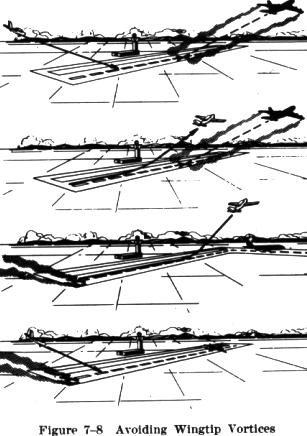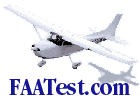| Wake Turbulence Avoidance
Just as powered boats do on water, every airplane generates a
wake while in flight. Initially, the disturbance was attributed to "prop wash."
It is now known, however, that this disturbance is caused by a pair of counter
rotating vortices trailing from the airplane's wingtips. The strong vortices
from large aircraft pose particular problems to light aircraft. In fact, the
wingtip vortices of these large aircraft can impose rolling moments that exceed
the control capability of many light aircraft. The manner in which this
hazardous phenomenon is created is explained in the chapter on Principles of
Flight and Performance Characteristics.
1. Landing behind a large airplane - on the same runway. Stay at or above the large aircraft's approach flightpath - note its touchdown point - then land beyond that point. 2. Landing behind a large airplane - when a parallel runway is closer than 2,500 feet, consider possible drift of the vortices to the other runway. Stay at or above the large airplane's final approach path - note its touchdown point - then land beyond that point. 3. Landing behind a large airplane - on a crossing runway: cross above the large airplane's flightpath. 4. Landing behind a departing large airplane - on the same runway. Note the large airplane's rotation point - then land well prior to its rotation point. 5. Landing behind a departing large airplane - on a crossing runway. Note the large airplane's rotation point - if it is past the runway intersection - continue the approach but land prior to the intersection, avoiding flight below the large airplane's flightpath. Abandon the approach unless a landing is assured well before reaching the intersection. 6. Departing behind a large airplane: Note the large airplane's rotation point - then rotate prior to the large airplane's rotation point and continue to climb above and stay upwind of the large airplane's climbpath until turning clear of its wake. Avoid subsequent headings which will cross below and behind a large airplane. Be alert for any critical takeoff situation which could lead to a vortex encounter. 7. Intersection takeoff - on the same runway: Be alert to adjacent large airplane operations particularly upwind of your runway. If an intersection takeoff clearance is received, avoid subsequent headings which will cross below a large airplane's path. 8. Departing or landing after a large airplane executing a low missed approach or touch and go landing: Because vortices settle and move laterally near the ground, the vortex hazard may exist along the runway and in your flightpath after a large airplane has executed a low missed approach or a touch and go landing, particularly in light quartering wind conditions. The pilot should assure that an interval of at least 2 minutes has elapsed before takeoff or landing.
|

